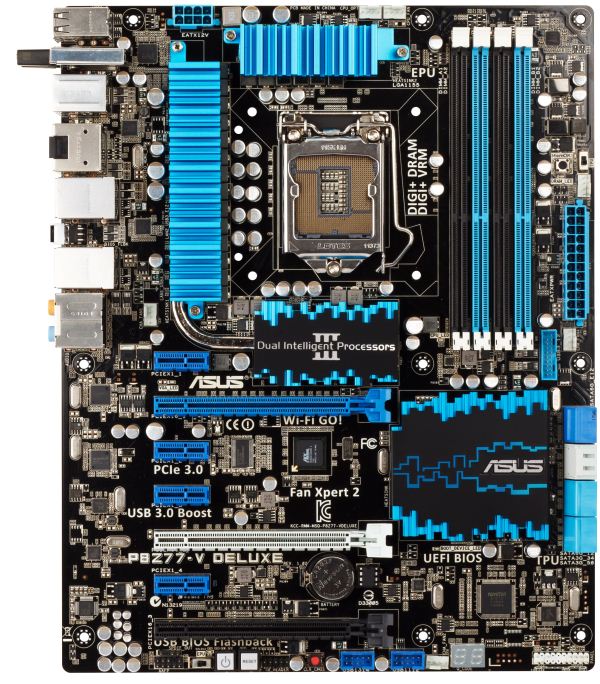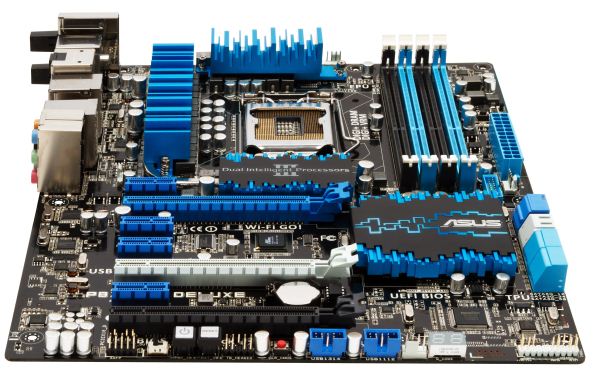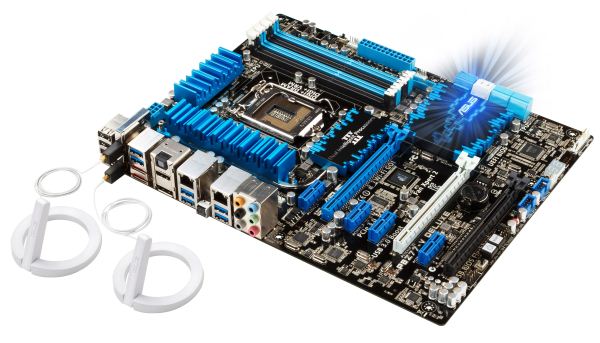Intel Z77 Panther Point Chipset and Motherboard Preview – ASRock, ASUS, Gigabyte, MSI, ECS and Biostar
by Ian Cutress on April 8, 2012 12:00 AM EST- Posted in
- Motherboards
- Intel
- Biostar
- MSI
- Gigabyte
- ASRock
- Asus
- Ivy Bridge
- ECS
- Z77
ASUS P8Z77-V Deluxe—Visual Inspection
In the next notch up in the channel board segregation, ASUS sell the Deluxe. This will be the first ASUS Deluxe board we have reviewed at AnandTech since the Llano mini-ITX F1A75-I Deluxe last year. In comparison to the P8Z77-V Pro, the Deluxe features several upgrades in terms of functionality and comfort.
The first to note is the increased power delivery to the CPU—this time in the form of a 16 + 4 phase power delivery. As a result, the VRM heatsinks to the left of the CPU are directly connected via a heatpipe to another heatsink below the socket. Also on board are the ‘enthusiast’ power/reset buttons and two-digit debug that we did not see on the Pro, and the use of dual NICs on the I/O, in the form of an Intel 82579V and a Realtek 8111F.
Due to the positioning off the heatsinks on the Deluxe compared to the Pro, the socket area seems a bit smaller (for example, the left hand heatsink is moved further in towards the socket), meaning that big air coolers may have a tougher time if they do not fit into Intel’s socket specification. Around the socket itself, we still have access to five fan headers—two 4-pin on the top of the board, one 4-pin to the bottom left of the main VRM heatsink, and one 4-pin either side of the 24-pin ATX power connector. A sixth fan header on board is found at the bottom next to the two-digit debug output.
Above the main power connector on the right hand side are the MemOK button and the TPU switch (for a fast automatic overclock). Below it is a USB 3.0 header, and a set of eight SATA ports. Similar to the ASUS Pro, we have four SATA 3 Gbps from the PCH, two SATA 6 Gbps also from the PCH, and two SATA 3 Gbps from a different controller—the Marvell 9128. This allows RAID 0/1 on these two SATA 6 Gbps ports.
The south side of the board still contains front panel headers and USB 2.0 ports, but also comes with the aforementioned power/reset buttons and two-digit debug display. We also find a ClearCMOS button on board, useful for overclockers. There is also a header labelled 'TB_Header', which should mean Thunderbolt, but there is no mention of it in the specifications. I will have to check up on this.
Update: The TB_Header is actually for a new Thunderbolt add-in card that ASUS will be selling. This is aimed to go into the x4 slot and provide Thunderbolt connectivity. MSRP will be around the $30-$40 mark so I am told.
In terms of the PCIe, we have a little bit of confusion. While in the middle between the PCIe is a PLX chip, it is not the PLX PXE 8747 chip that increases PCIe lane count. The one on the Deluxe is just to provide extra data transfer access for the various controllers on the motherboard. This means that the third full length PCIe in black is like other boards in that this is a PCIe 2.0 x4, non-GPU port. So from the top, we have a PCIe x1, x16 (x8 in Multi-GPU), x1, x1, x8, x1, x4. As a result, there is no PCIe to PCI bridge chip on this high-end model for PCI slots.
For the back panel, ASUS have done a juggling act deciding what to include. On the far left is a set of four USB 2.0 ports (black), a mini-PCIe WiFi + Bluetooth module, two USB 3.0 (blue), two eSATA, optical SPDIF output, HDMI output, DisplayPort, dual gigabit Ethernet, another four USB 3.0 ports (blue), a BIOS flashback button, and audio outputs. So in the name of a double NIC and 10 total USB ports on the back panel, we have lost D-Sub, DVI, IEEE1394 and a ClearCMOS button.
Board Features
| ASUS P8Z77-V Deluxe | |
| Size | ATX |
| CPU Interface | LGA-1155 |
| Chipset | Intel Z77 |
| Power Delivery | 16 + 4 |
| Memory Slots |
Four DDR3 DIMM slots supporting up to 32 GB Up to Dual Channel |
| Video Outputs | DisplayPort, HDMI |
| Onboard LAN |
Intel 82579V Realtek 8111F |
| Onboard Audio | Realtek ALC898 |
| Expansion Slots |
2 x PCIe x16 Gen3 (x16, x8/8) 1 x PCIe x16 Gen2 (x4) 4 x PCIe x1 Gen2 |
| Onboard SATA/RAID |
2 x SATA 6 Gbps (PCH), Support for RAID 0, 1, 5, 10 2 x SATA 6 Gbps (Marvell PCIe 9128), RAID 0, 1 4 x SATA 3 Gbps (PCH), Support for RAID 0, 1, 5, 10 2 x eSATA 6 Gbps (ASMedia) |
| USB |
Four USB 3.0 at rear (2 PCH, 2 ASMedia) Two USB 3.0 headers on board (PCH, ASMedia) Eight USB 2.0 (4 back panel, 4 on board) |
| Onboard |
4 x SATA 6 Gbps 4 x SATA 3 Gbps 1 x USB 3.0 Headers 2 x USB 2.0 Headers 6 x Fan Headers 1 x SPDIF Header 1 x Front Panel Audio Header 1 x TB Header MemOK! Button TPU/EPU Switches USB Flashback Button Power/Reset Buttons |
| Power Connectors |
1 x 24-pin ATX connector 1 x 8-pin 12V connector |
| Fan Headers |
1 x CPU Fan Header (4-pin) 4 x CHA Fan Headers 1 x OPT Fan Header |
| IO Panel |
2 x eSATA 6 Gbps 1 x DisplayPort 1 x HDMI 1.4a 2 x Gigabit Ethernet 6 x USB 3.0 4 x USB 2.0 1 x Optical SPDIF Audio Outputs Bluetooth V4.0 Wifi USB Flashback |
| Warranty Period | 3 Years |
| Product Page | Link |
Obviously one of the main selling points of the board is the onboard WiFi and Intel NIC (alongside a Realtek NIC).














145 Comments
View All Comments
t4murphy - Wednesday, April 18, 2012 - link
That was a good cpu for me before I went to the 920. I still ran MS FS9 with good results along with my GTX 8800. Im not laughing:)rocknrob - Thursday, April 12, 2012 - link
I had a 920 X58 setup and decided to rebuild to an i7 2700K Z68. So far I've regretted the whole thing. I'm going to pick up one of these ASUS Z77 Deluxe boards but I don't think it's going to make a big difference.The X58's/i7's were rock solid and performance monsters. I honestly see very little in terms of performance gains. Supposedly Ive Bridge processors are only going to give you about 15% to 20% increase in performance. If that's the case I think I'm going to stick with the 2700K until the next architecture change.
457R4LDR34DKN07 - Sunday, April 8, 2012 - link
you need to get a asus P8Z77-I DELUXE review.Mitxplease - Sunday, April 8, 2012 - link
Hells yes.GreenEnergy - Sunday, April 8, 2012 - link
I only found one (tiny) review sofar:http://vr-zone.com/articles/first-look-asus-p8z77-...
457R4LDR34DKN07 - Wednesday, April 11, 2012 - link
I actually would like a comparison with ZOTAC Z77-ITX WiFi, as I'm leaning toward the zotac mobo due to the msata compatibility by removing the wifi/bt module.ViperV990 - Sunday, April 8, 2012 - link
Does the Virtu MVP stuff work with an Eyefinity or NV Surround setup?martinw89 - Sunday, April 8, 2012 - link
I'm very curious about this too. On page two, Ian says "Within the hybrid system, the integrated GPU takes over two of the tasks for the GPU – snooping for required frames, and display output. This requires a system to run in i-Mode, where the display is connected to the integrated GPU."But on page 3, Lucid's own slide makes it sound like these new features are monitor configuration independent: http://images.anandtech.com/doci/5728/Lucid1.png
This is a super interesting feature, and I hope it performs as well in reality as it sounds like on paper. And with a triple screen setup it would be bliss.
jimnicoloff - Sunday, April 8, 2012 - link
I have a three monitor setup working just fine on a Z68 board with all monitors attached to a 6970. Virtu gives the option of which you want to be primary - the video card or the integrated graphics. So for me (with the video card primary) this works kind of backwards from a power saving point, but good for performance since it still allows for quick sync video transcoding, etc.I know this doesn't adress the new Virtu MVP, but I can't see them taking a step backwards when something similar works on the old version. Especially since if you are running in eyefinity mode it is just seen by the system as one big wide monitor and not three separate screens that each get their own render. Hopefully they can pull it off because I like my three screen setup and would hate to lose features because of that.
Zoomer - Tuesday, April 10, 2012 - link
I'm leading no:"This requires a system to run in <b>i-Mode, where the display is connected to the integrated GPU.</b>"